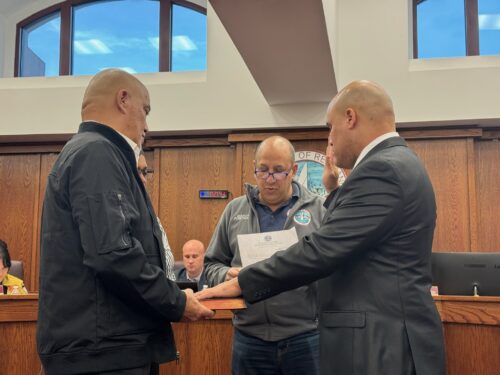
By JOHN T. WARD

One concerned retail and restaurant signage, which was the subject of an enforcement crackdown that generated considerable blowback a year ago.
The other is a trial run, using one store, to gauge the impact of allowing merchants to display wares in front of their stores.
• After some discussion, the council granted a request by Doc Shoppe owner Dean Ross to keep a table display in front of his Broad Street shoe store.
Ross noted that restaurants are now permitted to have sidewalk dining as long as it conforms to setback and other rules. He also said that because there’s a traffic-calming bumpout in front of his store, he’s got 17 feet from his storefont to the curb, “so there’s plenty of pedestrian clearance.”
He said no selling would occur outside, and that the table would be for display only.
But several officials, including Councilwoman Cindy Burnham, who serves as the council liaison to the code enforcement division, said that granting the request would open a “floodgate” of similar ones.
“If we let this table out, without a time limit, everyone’s going to want to do it,” she said.
“That could happen,” said Mayor Pasquale Menna.
“It will happen,” said Burnham.
Councilman Ed Zipprich agreed that in granting one request, “we’ll get another, and another.”
Officials of the downtown promotion agency RiverCenter spoke in favor of the measure, including vice chairman Tom Fishkin, who owns Readie’s Fine Foods two doors away from Doc Shoppe.
Menna said the town “needs to be proactive in terms of making sure we are competitive in every way” and giving retailers what they need to succeed in a difficult environment for brick-and-mortar shops.
But Burnham said the “code boys” at borough hall “have a problem with this” — namely, that it would encourage other merchants to roll out their own tables or even display racks of clothing.
But Councilman Mike DuPont argued that town officials “have to give retailers a shot at making it. Why not try it?” with a sunset provision, he asked.
Administrator Stanley Sickels suggested a 60-day trial, “and if it works for this individual, then we could draft some rules” allowing broader use.
On a voice vote, the council Ok’d the 60-day trial for Ross only.
• The council had also been expected to introduce an overhauled sign ordinance, one that’s been in the works for a year, ever since store and restaurant owners complained they’d suddenly gotten warning letters for signs they’d had in their windows for years.
Warnings were issued during a three-day blitz in May, 2014 to some two dozen businesses – ranging from Brothers Restaurant on West Front Street, which has featured neon signage for some 50 years, to Doc Shoppe, which had opened on Broad Street less than a month before. Another dozen or so received warnings for other types of variations, ranging from window coverage to improper placement of signs on awnings.
At Menna’s urging, the council agreed to halt enforcement and take a stab at fixing an ordinance that RiverCenter executive director Jim Scavone called “unwieldy” in its complexity.
A year later, that rewrite still isn’t completed, Menna suggested.
“The idea was to reduce the conflicting information” in the ordinance that would often force a merchant to hire a lawyer and even an engineer to navigate, he said. “That by and large has been accomplished. This a wonderful step out of the gate.”
But it’s still “extraordinarily burdensome to small businesses,” possibly requiring them to go to the zoning or planning board for an approval a process that could require hiring an attorney, an engineer and an architect, he said.
Menna said there should be an “administrative body” — consisting of the planning director, a council representative, a member of the business community, a voice for the Historic Preservation Commission and someone from code enforcement — with the authority to review signage requests and grant “licenses” for signs. A business that was rejected could then pursue the current process, he said.
Burnham agreed to take the suggestions into consideration and amend the ordinance further before its introduced.





















